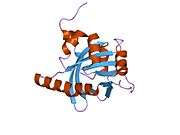SPEN
Msx2-interacting protein is a protein that in humans is encoded by the SPEN gene.[5][6][7]
This gene encodes a hormone inducible transcriptional repressor. Repression of transcription by this gene product can occur through interactions with other repressors, by the recruitment of proteins involved in histone deacetylation, or through sequestration of transcriptional activators. The product of this gene contains a carboxy-terminal domain that permits binding to other corepressor proteins. This domain also permits interaction with members of the NuRD complex, a nucleosome remodeling protein complex that contains deacetylase activity. In addition, this repressor contains several RNA recognition motifs that confer binding to a steroid receptor RNA coactivator; this binding can modulate the activity of both liganded and nonliganded steroid receptors.[7]
Interactions
SPEN has been shown to interact with HDAC1,[6] SRA1[6] and Nuclear receptor co-repressor 2.[6]
References
- GRCh38: Ensembl release 89: ENSG00000065526 - Ensembl, May 2017
- GRCm38: Ensembl release 89: ENSMUSG00000040761 - Ensembl, May 2017
- "Human PubMed Reference:". National Center for Biotechnology Information, U.S. National Library of Medicine.
- "Mouse PubMed Reference:". National Center for Biotechnology Information, U.S. National Library of Medicine.
- Newberry EP, Latifi T, Towler DA (Sep 1999). "The RRM domain of MINT, a novel Msx2 binding protein, recognizes and regulates the rat osteocalcin promoter". Biochemistry. 38 (33): 10678–90. doi:10.1021/bi990967j. PMID 10451362.
- Shi Y, Downes M, Xie W, Kao HY, Ordentlich P, Tsai CC, Hon M, Evans RM (May 2001). "Sharp, an inducible cofactor that integrates nuclear receptor repression and activation". Genes Dev. 15 (9): 1140–51. doi:10.1101/gad.871201. PMC 312688. PMID 11331609.
- "Entrez Gene: SPEN spen homolog, transcriptional regulator (Drosophila)".
Further reading
- Ternovskaia LN, Prokhorova LG, Moroz VM (1977). "[Antagonistic interrelationships between the staphylococci and Sarcina isolated from the upper respiratory tracts of virtually healthy persons]". Antibiotiki. 21 (12): 1072–5. PMID 1020939.
- Nagase T, Ishikawa K, Suyama M, et al. (1999). "Prediction of the coding sequences of unidentified human genes. XIII. The complete sequences of 100 new cDNA clones from brain which code for large proteins in vitro". DNA Res. 6 (1): 63–70. doi:10.1093/dnares/6.1.63. PMID 10231032.
- Shi Y, Hon M, Evans RM (2002). "The peroxisome proliferator-activated receptor delta, an integrator of transcriptional repression and nuclear receptor signaling". Proc. Natl. Acad. Sci. U.S.A. 99 (5): 2613–8. doi:10.1073/pnas.052707099. PMC 122396. PMID 11867749.
- Oswald F, Kostezka U, Astrahantseff K, et al. (2002). "SHARP is a novel component of the Notch/RBP-Jkappa signalling pathway". EMBO J. 21 (20): 5417–26. doi:10.1093/emboj/cdf549. PMC 129081. PMID 12374742.
- Ariyoshi M, Schwabe JW (2003). "A conserved structural motif reveals the essential transcriptional repression function of Spen proteins and their role in developmental signaling". Genes Dev. 17 (15): 1909–20. doi:10.1101/gad.266203. PMC 196244. PMID 12897056.
- Ota T, Suzuki Y, Nishikawa T, et al. (2004). "Complete sequencing and characterization of 21,243 full-length human cDNAs". Nat. Genet. 36 (1): 40–5. doi:10.1038/ng1285. PMID 14702039.
- Dotzlaw H, Papaioannou M, Moehren U, et al. (2004). "Agonist-antagonist induced coactivator and corepressor interplay on the human androgen receptor". Mol. Cell. Endocrinol. 213 (1): 79–85. doi:10.1016/j.mce.2003.10.036. PMID 15062576.
- Beausoleil SA, Jedrychowski M, Schwartz D, et al. (2004). "Large-scale characterization of HeLa cell nuclear phosphoproteins". Proc. Natl. Acad. Sci. U.S.A. 101 (33): 12130–5. doi:10.1073/pnas.0404720101. PMC 514446. PMID 15302935.
- Vadlamudi RK, Manavathi B, Singh RR, et al. (2005). "An essential role of Pak1 phosphorylation of SHARP in Notch signaling". Oncogene. 24 (28): 4591–6. doi:10.1038/sj.onc.1208672. PMID 15824732.
- Li J, Wang J, Yang X, et al. (2007). "The Spen homolog Msx2-interacting nuclear target protein interacts with the E2 ubiquitin-conjugating enzyme UbcH8". Mol. Cell. Biochem. 288 (1–2): 151–7. doi:10.1007/s11010-006-9131-9. PMID 16583136.
- Gregory SG, Barlow KF, McLay KE, et al. (2006). "The DNA sequence and biological annotation of human chromosome 1". Nature. 441 (7091): 315–21. doi:10.1038/nature04727. PMID 16710414.
- Lim J, Hao T, Shaw C, et al. (2006). "A protein-protein interaction network for human inherited ataxias and disorders of Purkinje cell degeneration". Cell. 125 (4): 801–14. doi:10.1016/j.cell.2006.03.032. PMID 16713569.
- Beausoleil SA, Villén J, Gerber SA, et al. (2006). "A probability-based approach for high-throughput protein phosphorylation analysis and site localization". Nat. Biotechnol. 24 (10): 1285–92. doi:10.1038/nbt1240. PMID 16964243.
- Olsen JV, Blagoev B, Gnad F, et al. (2006). "Global, in vivo, and site-specific phosphorylation dynamics in signaling networks". Cell. 127 (3): 635–48. doi:10.1016/j.cell.2006.09.026. PMID 17081983.
- Feng Y, Bommer GT, Zhai Y, et al. (2007). "Drosophila split ends homologue SHARP functions as a positive regulator of Wnt/beta-catenin/T-cell factor signaling in neoplastic transformation". Cancer Res. 67 (2): 482–91. doi:10.1158/0008-5472.CAN-06-2314. PMID 17234755.






